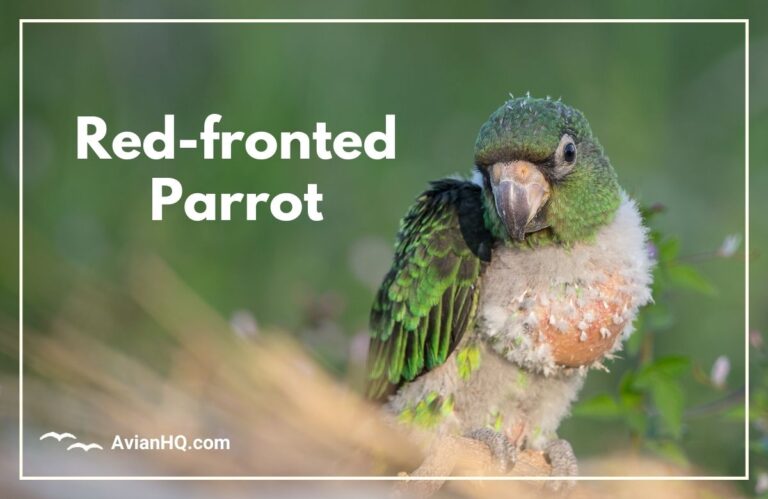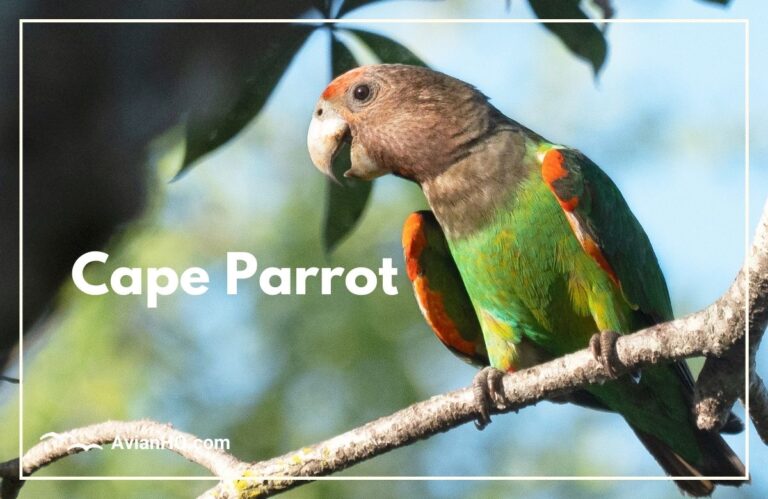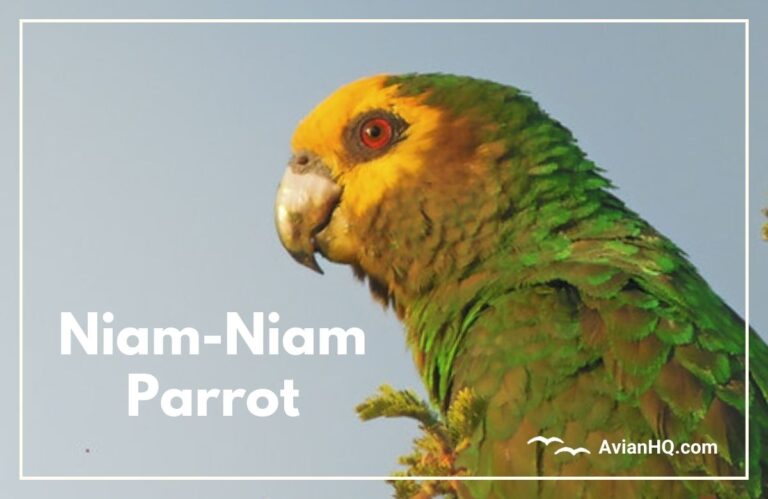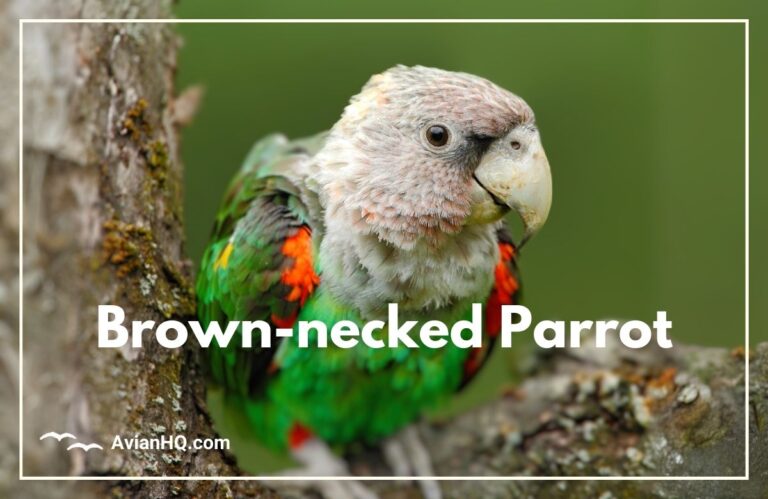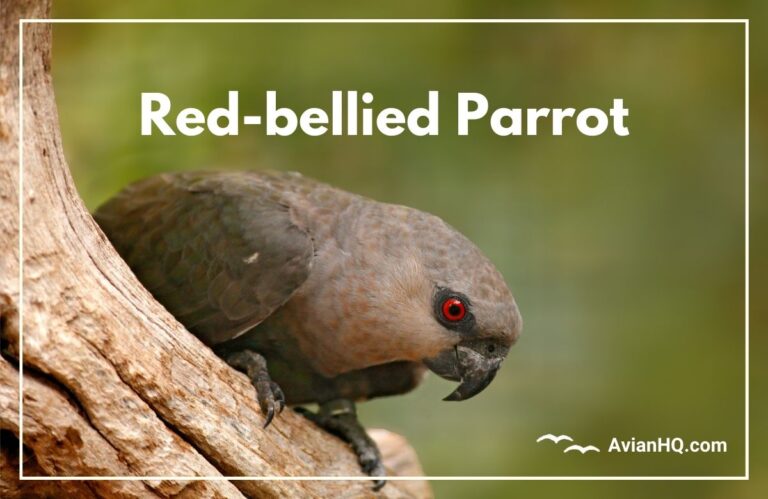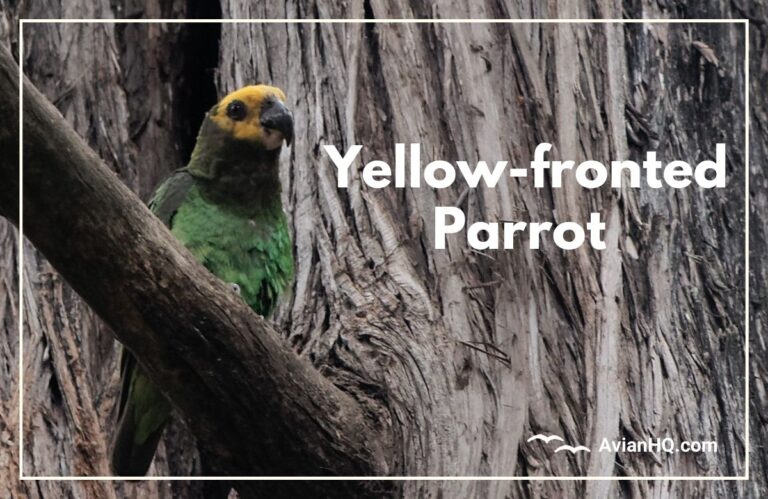Brown-headed Parrot (Poicephalus cryptoxanthus)
As you scan the bright green canopies of the woodlands in southeastern Africa, a flock of small parrots with greyish-brown heads may catch your eye. These are Brown-headed Parrots (Poicephalus cryptoxanthus), one of the continent’s most popular aviary birds. When taking flight, a flash of bright yellow on their wings gives a hint to how they got their Latin name which means “hidden yellow.”
Weighing only 4-5 ounces (115-140 grams) and reaching lengths of 8-9 inches (20-22 cm), Brown-headed Parrots have stocky bodies and short, rounded tails. Beyond the greyish-brown caps on their heads, their bodies display feathers of green, yellow, and blue for a uniquely colorful appearance among African parrots.
These small parrots inhabit a range stretching from South Africa’s eastern regions up through southern Malawi and Mozambique. Most often found below altitudes of 4,000 feet (1,200 meters), Brown-headed Parrots stick to woodlands and savannas where they can seek out tree hollows for nesting and dine on a diverse array of seeds, fruits, nectar, and vegetation.
While Brown-headed Parrot populations remain steady, their popularity in captivity combined with habitat loss does pose conservation threats. However, proper management of trade and land use can ensure these playful parrots continue brightening southeast Africa’s landscapes for years to come.
“These parrots display a distinctly curious, energetic, and friendly personality both in the wild and in captivity.”
Beyond a visually striking appearance, Brown-headed Parrots display a distinctly curious, energetic, and friendly personality both in the wild and in captivity. Their intelligence and quiet nature compared to other parrot species have further fueled their popularity as aviary birds.
History and Taxonomy
The first known description of the Brown-headed Parrot came from German naturalist Johann Friedrich Gmelin in 1788. However, it would be decades later in 1849 that German professor of zoology Johannes Theodor von Tschudi gave the species the binomial scientific name it still carries today:
- Poicephalus – From Greek meaning “grey head”
- cryptoxanthus – From Greek “hidden yellow”, referring to the bright yellow on their wings
Since Tschudi’s naming, three Brown-headed Parrot subspecies have been proposed according to slight variances in size, coloration, and geographic range:
- P.c. cryptoxanthus – The nominate race located across KwaZulu-Natal province, Swaziland, and northeastern South Africa through southern Mozamble.
- P.c. tanganyikae – Slightly larger and brighter-colored than the nominate race, it’s range stretches north from central Mozambique to southeast Kenya.
- P.c. zanzibaricus – Once native to Zanzibar and Pemba islands off Tanzania’s coast, this smallest subspecies is now likely extinct from hunting and interbreeding.
While these subspecies classifications were once accepted, most modern ornithological sources list the Brown-headed Parrot as a monotypic species with no distinct subspecies. Still, the past recognition of three potential subspecies speaks to the wide reach of the Brown-headed Parrot across southern and eastern Africa.
Physical Appearance and Characteristics
The green and grey colors of the Brown-headed Parrot give them a perfect camouflage among the leafy branches of their wooded habitat. Only when taking flight do splashes of bright yellow and blue on their wings shine like hidden treasure—the source of their Latin “cryptoxanthus” name.
Their stocky body and short tail contributes to a total length of 8-9 inches (20-22 centimeters). Average weights range from 4-5 ounces (115-150 grams). Beyond body measurements, several key features characterize their looks:
- Heads – As their name denotes, Brown-headed Parrots have greyish-brown caps from their foreheads down to their napes. Their heads can show olive-green hues in juveniles.
- Wings – Bright yellow patches on their underwing coverts only flash during flight. Blue margins along the outer primary wing feathers add another dash of color.
- Plumage – Backs, chests, bellies, and tail feathers all display vivid green hues. Faint blue markings may occur on the underparts and thighs on some birds.
- Beak – A sharp, narrow black beak turns whitish-horn at the base along the lower mandible.
- Eyes – Compared to the brown irises of juveniles, mature birds develop greyish-yellow eye coloration.
- Feet – Blackish-grey feet provide grip and stability among branches.
No stark differences occur between males and females. Only through DNA tests or surgical examination can the sexes be reliably distinguished.
The key identifiers to look for when trying to spot a Brown-headed Parrot are their green bodies paired with the greyish-brown caps on their heads – features that give them a uniquely charming appearance.
Habitat and Distribution
The reaches of the Brown-headed Parrots’ range stretches nearly 1,500 miles (~2,400 km) across southeastern Africa. Their native habitats center in Mozambique before expanding southward through eastern South Africa and Swaziland. Separate northern populations occur in southern Malawi, eastern Zimbabwe, and southeast Kenya.
Preferred elevations sit below 4,000 feet (1,200 meters). This allows Brown-headed Parrots to stick to lowland areas with temperatures suitable to their natural history.
In particular, they occupy dry, open woodlands dotted with broad-canopied trees. Tree species like baobabs, acacias, and figs help attract the parrots with ample flowers, seeds, fruits and insect prey. Grasslands, bushlands, and riparian forests also provide key habitat when linked to woodlands.
With a range comprised of various countries and habitat types, estimating total population sizes proves difficult. However, local populations appear consistent and Brown-headed Parrots maintain a widespread stronghold from southern to eastern Africa. This bodes well for their future as long as conservation considerations limit deforestation and trapping across their native lands.
The key habitats to remember for Brown-headed Parrots are dry woodlands and savannas with plenty of broad, flowering trees they rely on for food and nesting. This habitat preference centers their range across lowland areas of southeastern Africa.
Diet and Feeding
The habitats of the Brown-headed Parrots provide them with a diverse buffet of possible food sources. Their omnivorous diet capitalizes on a wide variety of fruits, flowers, seeds, and even occasional insects.
Key components of their diet include:
- Figs – Highly nutritious figs, especially from native Ficus trees, provide abundant energy.
- Fruits – Bananas, berries, pods from acacias and other trees supplement vitamins and carbohydrates.
- Seeds – Most woodland trees and shrubs produced edible seeds the parrots consume.
- Nectar – Bright flowering species like Aloe and baobabs offer sweet nourishment.
- Vegetation – Leaf buds, shoots, and certain crops add vegetable content.
Beyond natural foods, Brown-headed Parrots show enough flexibility to cause headaches for farmers. The parrots take advantage of crops like corn, millet, rice, and coconut palm products if the opportunity arises. Though this dietary versatility aids survival, it also creates conflicts with agricultural interests.
Feeding behaviors depend on food sources available across seasons. The parrots may carefully pick individual seeds, crack open figs and nuts with their sturdy beaks, feast on ripening fruits, or sip ample nectar from flowers. These flexible tactics allow efficient exploitation of the woodlands’ bounty.
In captivity, diets should mimic native foods with a quality mix of pellets, seeds, fruits, veggies, greens, and ample fresh water. Without sufficient calcium, caged parrots risk potentially fatal deficiencies.
Breeding and Reproduction
The breeding season for Brown-headed Parrots varies across their native range based primarily on rainfall and food availability. In general, mating and nesting occurs from April through October in southern Africa, while East African populations may nest in April/May or July through September.
They require tree hollows, whether natural or old woodpecker nests, to host their nest sites. Lined with decayed wood flakes but no additional padding, the female lays a small clutch of 2-4 white eggs. She takes on the majority of incubation duties over a period lasting around 26 days before the altricial chicks hatch.
Both parents share duties feeding the young chicks a diet of seeds and fruits. Chicks fledge at around 11 weeks old but continue to be fed by parents for another 1-2 months as they perfect their flying and foraging abilities. This prolonged post-fledge period is common in parrots and improves the survival rates of offspring.
In captivity, Brown-headed Parrots respond well to breeding and can produce robust numbers of offspring. However, mortality rates in captive-hatched chicks are high if intensive care is not provided in raising them. Their average longevity as pets ranges from 15-30 years if properly cared for.
Key facets of their reproduction to remember include:
- April-October breeding timed with food availability
- Nesting in tree hollows
- Clutches of 2-4 white eggs
- 26 days of female-dominated incubation
- 11 weeks to fledging, further parental care needed
With attentive parental care in the wild and supportive captive management, Brown-headed Parrot numbers remain consistent across most of their native range.
Behavior and Ecology
The activity patterns of Brown-headed Parrots revolve around exploiting food resources across the east African woodlands they inhabit. Their social and foraging behaviors provide clues into their ecological roles.
Brown-headed Parrots live in permanent flocks year-round. During non-breeding seasons, flocks range from small groups of 5-10 up to aggregations of 50 individuals. These flocks roost communally in large tree hollows or dense vegetation, flying out during mornings to favored feeding areas.
Foraging takes place slowly and methodically through trees and over ground vegetation. Their strong beaks allow easy access to seeds and fruit. Feeding flocks produce constant soft chattering and murmurs. Around midday when heat peaks, they take a break for drinking before another round of afternoon foraging.
Flocks appear very social and coordinate their actions. Some may act as sentinels keeping watch for predators while others feed. Alert calls signal danger, triggering swift escapes into thick cover.
Beyond their own species, Brown-headed Parrots integrate fairly peacefully with other birds. Large African parrots may displace them at choice feeding spots, but they mostly occupy separate foraging niches. Their periodic crop-raiding does certainly pit them against the interests of human farmers however.
So from dawn to dusk, social groups forage relentlessly to support their high metabolism. This continual feeding underscores the Brown-headed Parrot’s important role as a seed disperser and generalist consumer helping shape Africa’s woodland ecosystems. Their visibility in bright flocks likewise gives them ecological value through weed control, pollination, and nutrient cycling across their geographic range.
Conservation Status and Threats
The global population status of Brown-headed Parrots is difficult to quantify across their wide but fragmented range. Local populations appear consistent and may number in the tens of thousands in countries like South Africa. However, threats from habitat loss to poaching do require conservation considerations.
The IUCN Red List categorizes Brown-headed Parrots as Least Concern currently, but notes their numbers are in decline across portions of their range. Total populations likely number above 100,000 mature individuals though.
Major threats include:
- Deforestation – Logging, land conversion, and development shrink the woodlands Brown-headed Parrots rely on for nesting and feeding.
- Wild-Caught Trapping – Significant numbers trapped for the pet trade in Mozambique in particular.
- Persecution as Crop Raiders – Hunted or poisoned in retaliation for crop damages by some farmers.
Protected areas across Malawi, South Africa, and other countries provide refuge to sustain populations. But pressures from illegal trade and habitat encroachment continue mounting in unprotected areas.
Increased patrolling against poaching and integrating woodland conservation needs into development plans can keep the Brown-headed Parrot from requiring a more threatened conservation status. Maintaining commodity chains free of wild-caught individuals will also curb trapping incentives.
With care taken to monitor key populations, limit deforestation, and reduce unsustainable trapping, the “hidden yellows” can maintain vibrant flocks across their southeast African range.
Cultural Significance
The attractive appearance and sociable, quiet personalities of Brown-headed Parrots have made them immensely popular caged birds. Their adaptability to captivity and prolific breeding rates feed vigorous legal and illegal trades across Africa and abroad.
Native tribes have kept pet parrots for centuries. But broader domestic and international demands for the species as cage birds grew over the 1900s. South Africa, Mozambique, and Somalia serve as exporters for legal and illegal trades in wildlife markets globally.
Beyond living rooms, Brown-headed Parrots also interact with humans via their crop-raiding behaviors. Where natural vegetation grows scarce, the opportunistic parrots turn to crops like corn, rice, coconut, and other grains for sustenance. Farmers retaliate by hunting parrots or lacing crops with poisons – a major threat driving declines.
- Pets – Wild-caught exports number 10,000-19,000 annually, mostly from trappers serving markets in the Middle East and Asia. Captive-bred birds also supplement legal trade.
- Pests – Persecution by farmers for crop damages takes a significant toll on regional flocks.
This dual status as beloved pet and pestilent pest leaves complex conservation challenges around the Brown-headed Parrot. Sustainable management of both captive breeding and wild flocks will provide paths for peaceful co-existence with humans across their range.
The cultural ties of Brown-headed Parrots as aviary birds mixes perilously with their crop raiding behaviors. Seeking balance will allow continued appreciation of their bright plumes rather than conflict alone.
Conclusion
In wooded habitats across Mozambique, Malawi, Zimbabwe, and beyond, the Brown-headed Parrot maintains stable populations as a uniquely colored and gregarious African parrot. These “hidden yellows” fill ecological roles from seed dispersal to pest control while regaling observers with their bright plumages and noisy flocks.
Yet an insatiable desire for the Brown-headed Parrot as pets coupled with ongoing habitat degradation does impact local numbers. Addressing rampant trapping and integrating conservation priorities into development plans are crucial for long-term population viability.
If deforestation can be controlled and more ethical, sustainable management achieved of both captive and wild flocks, these playful parrots have hope. Though chased at times as agricultural pests, their asking is simple – shelter among branches, adequate nourishment, and tree hollows to safely rear next generations of “hidden yellows”.
Whether viewed as a captivating companion or essential component of African ecosystems, the Brown-headed Parrot warrants increased conservation attention and environmental protections across southeastern countries. Achieving balance between human interests and maintenance of healthy woodland habitats will allow perseverance of these small parrots with their gray caps, green wings, and moments of golden flashes.


